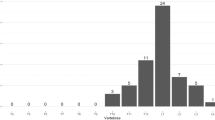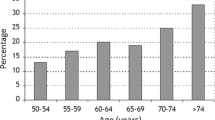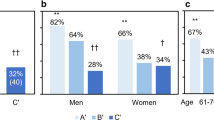Abstract
We examined whether the prevalence of vertebral fractures in otherwise healthy, 70-year-old Danish women had increased during an interval of 10 years. The population-based epidemiological study included two age-matched groups of postmenopausal women. Group 1 consisted of 70-year-old women (n=386) living in a defined area of suburban Copenhagen recruited in 1979 for an epidemiological study. Of the 285 women who were entered, 173 were judged healthy, without secondary causes of osteoporosis. Group 2 was recruited by sending questionnaires to all women aged 68–72 years living in the same area in 1989. Of the 512 women who attended a medical screening, 387 were found to be without secondary causes of osteoporosis and had a spinal radiograph. Radiographs of the thoracolumbar spine were assessed for vertebral fracture by five radiological methods. There was no significant difference between the two groups in the prevalence of vertebral fractures and the 95% confidence intervals overlapped completely in all methods. The prevalence rates varied by method from about 35% to more than 80% but the distribution of fracture types was similar in the two groups. We conclude that the prevalence of vertebral fractures due to postmenopausal osteoporosis has not increased since 1979 in otherwise healthy women residing in suburban Copenhagen, and that comparison of prevalences between studies requires that they use the same method of radiological assessment.
Similar content being viewed by others
References
Cummings SR, Kelsey JL, Nevitt MC, O'Dowd KJ. Epidemiology of osteoporosis and osteoporotic fractures. Epidemiol Rev 1985;7:178–208.
Sernbo I, Johnell O, Andersson T. Differences in the incidence of hip fracture: comparison of an urban and a rural population in southern Sweden. Acta Orthop Scand 1988;59:382–5.
deDeuxchaisnes NC, Devogelaer J-P. Increase in the incidence of hip fractures and of the ratio of trochanteric to cervical hip fractures in Belgium. Calcif Tissue Int 1988;42:201–3.
Wallace WA. The increasing incidence of fractures of the proximal femur: an orthopaedic epidemic. Lancet 1983;2:1413–4.
Lindsay R, Dempster DW, Clemens T, Herrington BS, Wilt S. Incidence, cost, and risk factors of fracture of the proximal femur in USA. In: Christiansen C, Arnaud CD, Nordin BEC, Parfitt AM, Peck WA, Riggs BL, editors. Osteoporosis: Proceedings of the International Symposium on Osteoporosis, Copenhagen, Denmark. Aalborg Stiftsbogtrykkeri, 1984:311–5.
Martin AD, Silverthorn KG, Houston CS. Age-specific increase in hip fractures in Canada. In: Christiansen C, Johansen JS, Riis BJ, editors. Osteoporosis 1987: Proceedings of the International Symposium on Osteoporosis, Aalborg, Denmark. Copenhagen: Osteopress ApS, 1987:111–2.
Melton III LJ, O'Fallon WM, Riggs BL, Secular trends in the incidence of hip fractures. Calcif Tissue Int 1987;41:57–64.
Spector TD, Cooper C, Lewis AF. Trends in admissions for hip fracture in England and Wales, 1968–1985. Br Med J 1990;300:1173–4.
Rehnberg L, Olerud C. Incidence of hip fractures in the elderly. Uppsala County 1980–1987. Acta Orthop Scand 1990; 61:148–51.
Naessen T, Parker R, Persson I, Zack M, Adami HO. Time trends in incidence rates of first hip fracture in the Uppsala Health Care Region, Sweden, 1965–1983. Am J Epidemiol 1989;130:289–99.
Bengnér U, Johnell O. Increasing incidence of forearm fractures: a comparison of epidemiologic patterns 25 years apart. Acta Orthop Scand 1985;56:158–60.
Bengnér U, Johnell O, Redlund-Johnell I. Changes in the incidence of fracture of the upper end of the humerus during a 30-year period: a study of 2125 fractures. Clin Orthop Rel Res 1988;231:179–82.
Daly PJ, Fitzgerald RH, Melton LJ, Ilstrup DM. Epidemiology of ankle fractures in Rochester, Minnesota. Acta Orthop Scand 1987;58:539–44.
Bengnér U, Johnell O, Redlund-Johnell I. Changes in incidence and prevalence of vertebral fractures during 30 years. Calcif Tissue Int 1988;42:293–6.
Jensen GF, Christiansen C, Boesen J, Hegedüs V, Transbøl I. Epidemiology of postmenopausal spinal and long bone fractures: a unifying approach to postmenopausal osteoporosis. Clin Orthop Rel Res 1982;166:75–81.
Melton III LJ, Kan SH, Frye MA, Wahner HW, O'Fallon WM, Riggs BL. Epidemiology of vertebral fractures in women. Am J Epidemiol 1989;129:1000–11.
Minne HW, Leidig G, Wüster C, et al. A newly developed spine deformity index (SDI) to quantitate vertebral crush fractures in patients with osteoporosis. Bone Miner 1988;3:335–49.
Hedlund LR, Gallagher JC. Vertebral morphometry in diagnosis of spinal fractures. Bone Miner 1988;5:59–67.
Overgaard K, Hansen MA, Riis BJ, Christiansen C. Discriminatory ability of bone mass measurements (SPA and DEXA) for fractures in elderly postmenopausal women. Calcif Tissue Int 1992;50:30–5.
A report of ICRP Committee 3. Data for protection against ionizing radiation from external sources. ICRP publication 21. Oxford: Pergamon Press, 1973.
Smith-Bindman R, Cummings SR, Steiger P, Genant HK. A comparison of morphometric definitions of vertebral fracture. J Bone Miner Res 1991;6:25–34.
Kleerekoper M, Parfitt AM, Ellis BI. Measurement of vertebral fracture rates in osteoporosis. In: Osteoporosis: Proceedings of the International Symposium on Osteoporosis, Copenhagen, Denmark. Aalborg Stiftsbogtrykkeri, 1984;:103–9.
Nilas L, Borg J, Gotfredsen A, Christiansen C. Comparison of single- and dual-photon absorptiometry in postmenopausal bone mineral loss. J Nucl Med 1985;26: 1257–62.
Gardner MJ, Altman DG. Confidence intervals rather thanP values: estimation rather than hypothesis testing. Br Med J 1986;292:746–50.
Seldin DW, Esser PD, Alderson PO. Comparison of bone density measurements from different skeletal sites. J Nucl Med 1988;29:168–73.
Hansen MA, Riis BJ, Overgaard K, Hassager C, Christiansen C. Bone mass measured by photon absorptiometry: comparison of forearm, heel, and spine. Scand J Clin Lab Invest 1990;50:517–23.
Ott SM, Kilcoyne RF, Chesnut III CH. Ability of four different techniques of measuring bone mass to diagnose vertebral fractures in postmenopausal women. J Bone Miner Res 1987;2:201–10.
Gotfredsen A, Pødenphant J, Nilas L, Christiansen C Discriminative ability of total body bone-mineral measured by dual photon absorptiometry. Scand J Clin Lab Invest 1989;49:125–34.
Sernbo I, Johnell O. Changes in bone mass and fracture type in patients with hip fracture: a comparison between 1950 and 1980 in Malmö, Sweden. Clin Orthop Rel Res 1988;233:95–103.
Obrant KJ, Bengnér U, Johnell O, Nilsson BE, Sernbo I. Increasing age-adjusted risk of fragility fractures: a sign of increasing osteoporosis in successive generations? Calcif Tissue Int 1989;44:157–67.
Rees JL. Accuracy of hospital activity data in estimating the incidence of proximal femoral fracture. Br Med J 1982;284:1856–7.
Sauer P, Leidig G, Minne HW, et al. Spine deformity index (SDI) versus other objective procedures of vertebral fracture identification in patients with osteoporosis: a comparative study. J Bone Miner Res 1991;6:227–38.
Author information
Authors and Affiliations
Rights and permissions
About this article
Cite this article
Hansen, M.A., Overgaard, K., Nielsen, V.A.H. et al. No secular increase in the prevalence of vertebral fractures due to postmenopausal osteoporosis. Osteoporosis Int 2, 241–246 (1992). https://doi.org/10.1007/BF01624148
Received:
Accepted:
Issue Date:
DOI: https://doi.org/10.1007/BF01624148




